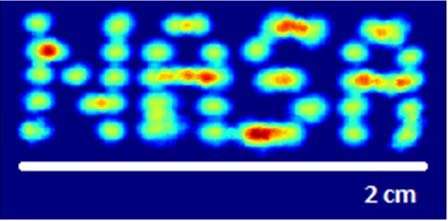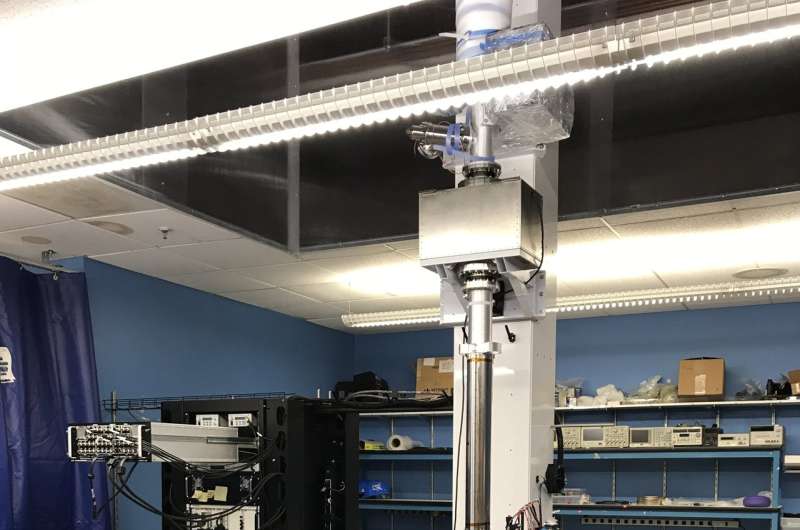Team creates and demonstrates first quantum sensor for satellite gravimetry

NASA and the Sunnyvale, California-based AOSense, Inc., have successfully built and demonstrated a prototype quantum sensor capable of obtaining highly sensitive and accurate gravity measurements—a stepping stone toward next-generation geodesy, hydrology, and climate-monitoring missions in space.
The prototype sensor, developed in collaboration with NASA's Goddard Space Flight Center in Greenbelt, Maryland, employs a revolutionary measurement technique called atom interferometry, which former U.S. Energy Department Secretary Steven Chu and his colleagues invented in the late 1980s. In 1997, Chu received the Nobel Prize in Physics for his work.
Since the discovery, researchers worldwide have attempted to build practical, compact, more sensitive quantum sensors, such as atom interferometers, that scientists could use in space-constrained areas, including spacecraft.
With funding from NASA's Small Business Innovation Research, Instrument Incubator, and Goddard's Internal Research and Development programs, the Goddard-AOSense team developed an atom-optics gravity gradiometer primarily for mapping Earth's time-varying gravitational field. Although Earth's gravitational field changes for a variety of reasons, the most significant cause is a change in water mass. If a glacier or an ice sheet melts, this would affect mass distribution and therefore Earth's gravitational field
"Our sensor is smaller than competing sensors with similar sensitivity goals," said Babak Saif, a Goddard optical physicist and collaborator in the effort. "Previous atom interferometer-based instruments included components that would literally fill a room. Our sensor, in dramatic comparison, is compact and efficient. It could be used on a spacecraft to obtain an extraordinary data set for understanding Earth's water cycle and its response to climate change. In fact, the sensor is a candidate for future NASA missions across a variety of scientific disciplines."
Atom interferometry works much like optical interferometry, a 200-year-old technique used in science and industry to measure small displacements in objects. Optical interferometry obtains measurements by comparing light that has been split between two different paths. When the beams from these two paths recombine, they create an interference-fringe pattern that scientists inspect to obtain highly precise measurements.

Atom interferometry, however, hinges on quantum mechanics, the theory that describes how matter behaves at sub-microscopic scales. Atoms, which are highly sensitive to gravitational signals, can also be cajoled into behaving like light waves. Special pulsing lasers can split and manipulate atom waves to travel different paths. The two atom waves will interact with gravity in a way that affects the interference pattern produced once the two waves recombine. Scientists can then analyze this pattern to obtain an extraordinarily accurate measure of the gravitational field.
In particular, the team is eying its quantum sensor as a potential technology to gather the type of data currently produced by NASA's Gravity Recovery and Climate Experiment (GRACE) Follow-On mission. GRACE-FO is a two-satellite mission that has generated monthly gravity maps showing how mass is distributed and how it changes over time. Due to its extraordinary precision, the quantum sensor could eliminate the need for a two-satellite system or provide even greater accuracy if deployed on a second satellite in a complementary orbit, said Lee Feinberg, a Goddard optics expert also involved in the effort.
"With this new technology, we can measure the changes of Earth's gravity that come from melting ice caps, droughts, and draining underground water supplies, greatly improving on the pioneering GRACE mission," said John Mather, a Goddard scientist and winner of the Nobel Prize in Physics in 2006 for his work on NASA's Cosmic Background Explorer that helped cement the big-bang theory of the universe.
The instrument, however, could be used to answer other scientific questions.
"We can measure the interior structure of planets, moons, asteroids, and comets when we send probes to visit them. The technology is so powerful that it can even extend the Nobel-winning measurements of gravitational waves from distant black holes, observing at a new frequency range," Mather said, referring to the confirmation in 2015 of cosmic gravitational waves—literally, ripples in the fabric of space-time that radiate out in all directions, much like what happens when a stone is thrown into a pond. Since that initial confirmation, the Laser Interferometer Gravitational Wave Observatory and the European Virgo detectors have detected other events.
Since 2004, AOSense has developed quantum sensors and atomic clocks, with broad expertise and capabilities spanning all aspects of development and characterization of advanced sensors for precision navigation and timing.
Provided by NASA's Goddard Space Flight Center




















